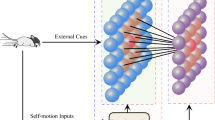Abstract
Dynamic neural fields have been used extensively to model brain functions. These models coupled with the mechanisms of path integration have further been used to model idiothetic updates of hippocampal head and place representations, motor functions and have recently gained interest in the field of cognitive robotics. The sustained packet of activity of a neural field combined with a mechanism for moving this activity provides an elegant representation of state using a continuous attractor network. Path integration (PI) is dependent on the modulation of the collateral weights in the neural field. This modulation introduces an asymmetry in the activity packet, which causes a movement of the packet to a new location in the field. The following work provides an analysis of the PI mechanism, with respect to the speed of the packet movement and the robustness of the field under strong rotational inputs. This analysis illustrates challenges in controlling the activity packet size under strong rotational inputs, as well as a limited speed capability using the existing PI mechanism. As a result of this analysis, we propose a novel modification to the weight combination method to provide a higher speed capability and increased robustness of the field. The results of this proposed method are an increase in over two times the existing speed capability and a resistance of the field to break down under strong rotational inputs.













Similar content being viewed by others
References
Taylor J. Bubbles in the brain? Trends Cogn Sci. 2003;7:429–31.
Stringer SM, Rolls ET, Trappenberg TP, de Araujo IET. Self-organizing continuous attractor networks and motor function. Neural Netw. 2003;16:161–82.
Stringer SM, Rolls ET, Trappenberg TP. Self-organising continuous attractor networks with multiple activity packets, and the representation of space. Neural Netw. 2004;17:5–27.
Amari SI. Dynamics of pattern formation in lateral-inhibition type neural fields. Biol Cybern. 1977;27:77–87.
Petersen RS, Taylor JG. Reorganization of somato-sensory cortex after tactile training. In: Touretsky DS, editor. Advances in neural information processing, systems. Cambridge: MIT Press; 1996. p. 82–8.
Fellenz W, Taylor JG. Establishing retinotopy by lateral inhibition-type homogeneous neural fields. In: ESANN proceedings; 2000. p. 200–49.
Taylor JG. Perception by neural networks. Neural Netw World. 1997;4:363–95.
Stringer SM, Rolls ET, Trappenberg TP, de Araujo IET. Self-organising continuous attractor networks and path integration: one-dimensional models of head direction cells. Netw Comput Neural Syst. 2002;13:217–42.
Stringer SM, Rolls ET, Trappenberg TP, de Araujo IET. Self-organising continuous attractor networks and path integration: two-dimensional models of place cells. Netw Comput Neural Syst. 2002;13:429–46.
Stringer SM, Rolls ET, Trappenberg TP. Self-organising continuous attractor network models of hippocampal spatial view cells. Neurobiol Learn Mem. 2005;83:79–92.
Trappenberg TP. Fundamentals of computational neuroscience. Oxford: Oxford University Press; 2002.
Taylor JG. The race for consciousness. Bradford Books: Cambridge; 2001.
Taylor JG, Alavi FN. A global competitive neural network. Biol Cybern. 1995;72:233–48.
Wilson HR, Cowan JD. Excititory and inhibitory interactions in localized populations of model neurons. Biophys J. 1972;12:1–24.
Wilson HR, Cowan JD. A mathematical theory of the functional dynamics of cortical and thalamic nervous tissue. Kybernetik. 1973;13:55–80.
Taylor JG. Neural ‘bubble’ dynamics in two dimensions: foundations. Biol Cybern. 2000;80:393–409.
Doubrovinski K, Herrmann JM. Stability of localized patterns in neural fields. Neural Comput. 2009;21:1125–44.
Jancke D, Erlhagen W, Schoner G, Dinse H. Shorter latencies for motion trajectories than for flashes in population responses of a cat primary visual cortex. J Physiol. 2004;556(3):971–82.
Trappenberg TP, Dorris M, Munoz DP, Klein RM. A model of saccade initiation based on the competitive integration of exogenous and endogenous signals in the superior colliculus. J Cogn Neurosci. 2001;13:256–71.
Rolls ET, Stringer SM, Trappenberg TP. A unified model of spatial and episodic memory. Proc R Soc. 2002;269:1087–93.
Zhang K. Representation of spatial orientation by the intrinsic dynamics of the head direction cell ensemble: a theory. J Neurosci. 1996;16:2112–26.
Milford MJ, Wyeth GF, Prasser D. RatSLAM: a hippocampal model for simulataneous localization and mapping. In: Proceedings of the IEEE international conference on robotics and automation; 2004. p. 403–8.
Zibner SK, Faubel C, Iossifidis I, Schoner G. Dynamic neural fields as building blocks of a cortex-inspired architecture for robotic scene representation. IEEE Trans Auton Ment Dev. 2011;3:74–91.
Erlhagen W, Bicho E. The dynamic neural field approach to cognitive robotics. J Neural Eng. 2006;3:36–54.
McNaughton BL, Battaglia FP, Jensen O, Moser EI, Moser M. Path integration and the neural basis of the ‘cognitive map’. Nat Rev Neurosci. 2006;7:663–78.
Samsonovich A, McNaughton BL. Path integration and cognitive mapping in a continous attractor neural network model. J Neurosci. 1997;17:5900–20.
Skaggs WE, Knierim JJ, Kudrimoti HS, McNaughton BL. 1995 A model of the neural basis of the rats sense of direction In: Tesauro G, Touretzky DS, Leen TK, editors. Advances in neural information processing systems, vol 7. Cambridge: MIT Press; 1995. p. 173–80.
Xie X, Hahnloser RH, Seung HS. Double-ring network model of the head-direction system. Phys Rev E Stat Nonlin Soft Matter Phys. 2002;66:041902.
Milford MJ, Wiles J, Wyeth GF. Solving navigational uncertainty using grid cells on robots. PLoS Comput Biol. 2010;6(11):e1000995. doi:10.1371/journal.pcbi.1000995.
Author information
Authors and Affiliations
Corresponding author
Rights and permissions
About this article
Cite this article
Connors, W.A., Trappenberg, T. Improved Path Integration Using a Modified Weight Combination Method. Cogn Comput 5, 295–306 (2013). https://doi.org/10.1007/s12559-013-9209-0
Received:
Accepted:
Published:
Issue Date:
DOI: https://doi.org/10.1007/s12559-013-9209-0




